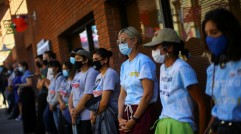Peru Cuts Coca Leaf Production by 17.5 Percent; Country Encourages Different Crops Instead
Peru has moved forward on the cocaine front in the last year, dealing a blow to cultivation but not still affecting overall production and export. However, the Peruvian government sees the progress as a positive result of anti-drug policies in the country despite their potential to alienate the poor.
Peru is one of the world's top producing cocaine nations, exchanging first and second place with Colombia every so often. Like its northern neighbor, Peru has battled drug production within its borders for decades with little success. In recent years, remnants of Peru's Shining Path terrorist group have taken up cocaine production, adding to the government's troubles.
President Ollanta Humala, however, achieved success this past year. According to the Wall Street Journal, Peru has managed to reduce coca-leaf production by 17.5 percent in the last year. The United Nations Office on Drugs and Crime (UNODC) and the Peruvian government announced this in a report that revealed progress in various coca-leaf-producing areas.
Unlike Colombia, which is using fumigation, Peru opted for a program that pulls all the crops from the ground manually by groups of men monitored by the National Police. The Wall Street Journal reports that the drop in production this past year has been the best result in the last 14 years, with coca-growing areas dropping to 121,000 acres in 2013.
"The significance of the reduction in 2013 comes after many years of growth and is due to not only to better eradication, but also to post-eradication activities," said Flavio Mirella, Lima-based director of the United Nations Office on Drugs and Crime for Peru and Ecuador.
Despite the success of the policy, it can have negative ramifications for the government. President Humala won thanks to support from coca growers and originally was against ripping out the plants, but his change of heart or, at least, policy could alienate the people in the Peruvian Andes, where much of the coca is produced.
El Comercio, a Peruvian newspaper, adds that 55.5 percent coca-leaf production happens in the regions of Ayacucho and Cuzco. Success has been recorded in regions of the Monzon River and the Tingo María-Supte-Aucayacu junction. The report also stated a fourth consecutive reduction in coca-leaf production in the region, which halved the area cultivating coca-leaf.
However, the Wall Street Journal adds, Peru's government plans to push for a different tactic: encouraging poor farmers to plant legal crops.
Last week, President Humala announced a new strategy to curb coca-leaf production in the VRAE area, which stands for Valley of the Apurimac, Ene (and Mantaro) River. This is Peru's largest coca-producing region and the Peruvian government hopes to encourage farmers to begin planting legal crops like cocoa and coffee in the region.
"To enter into the Vrae, we have to follow an imaginative strategy and not only eradicate. We have to have a strategy of conversion to alternative crops, without disqualifying eradication, which in this case isn't functioning," Mr. Humala said.
The U.S. government supports the efforts made by the Humala administration and has praised the recent success; however, without the support of the farmers, what has been achieved now will vanish quickly when new coca is planted. Peru's government has never been very popular in the jungle regions where most coca is produced and faces the ire of farmers who lose their livelihood without any substantial replacement, so the Humala administration must implement the alternative cultivation plans soon to not take away from their progress.
Subscribe to Latin Post!
Sign up for our free newsletter for the Latest coverage!
* This is a contributed article and this content does not necessarily represent the views of latinpost.com














